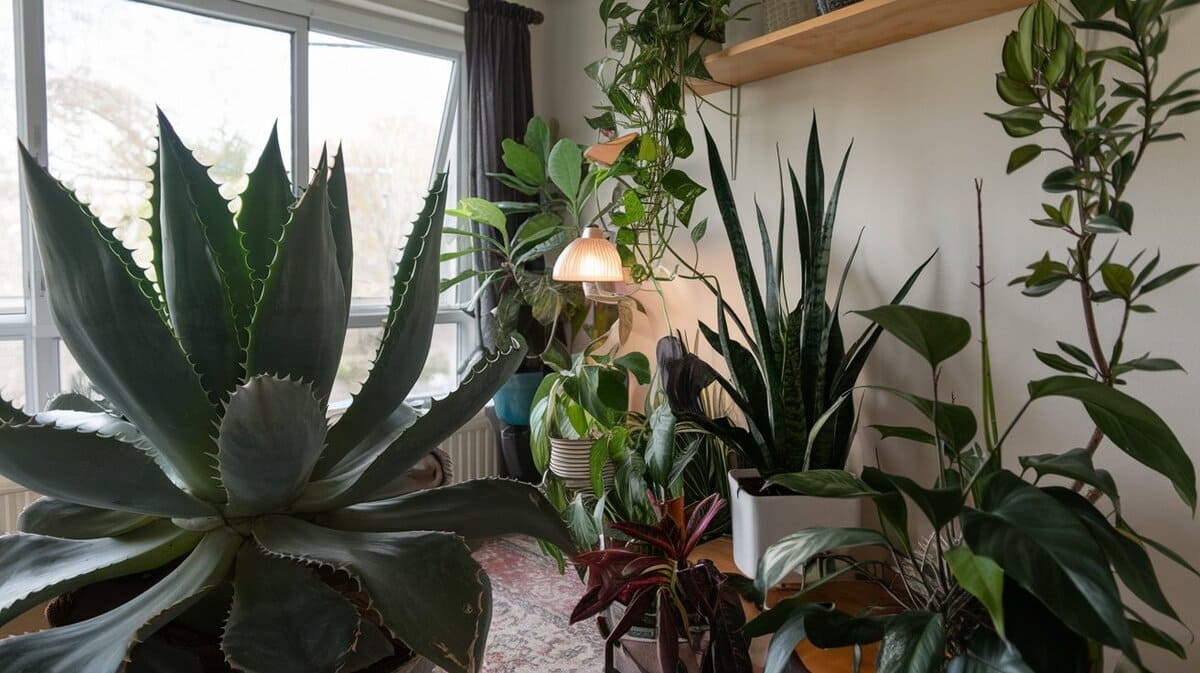
Thus, an interest in inside gardening has increased, and for very apparent reasons. Due to today’s involved schedules and a variety of different environments that individuals live in, individuals are interested in plants that can successfully grow in a low light environment. Indoor plants that grow in low light are ideal for people who do not have many windows or a lot of light coming in their homes but still would love to have some real green feel.
In this ultimate guide, you will find an overview of what low light indoor plants are, why grow them, how to properly take care of these plants, what issues the owner may encounter and recommendations of the 20 best low-light indoor plants to have at home.
1. What Are Low Light Indoor Plants?
Indoor plants that grow under low light mean plants that can handle little light inside buildings or houses. It grows well in rooms where there is little exposure to direct light or in spaces with small windows and receive diffused light. This doesn’t mean that the plants can grow well in extreme darkness: low-light just refers to their love for the shady or semi-shady places; therefore, they are suitable as the interior plants for the homes and offices with not very good lighting.
Most low light plants are found in the under vegetation part where they are exposed to limited amounts of light. Some observed alterations include increased leaf size for increased light capture, reduced growth rates and ability to carry out photosynthesis optimally despite phenotypic shading. Knowledge of these adaptations is crucial to the proper development of cultivations of these plants in the home environment.
Top Benefits of Growing Low Light Indoor Plants :
Why Choose Low Light Plants for Your Home?
Low-light indoor plants offer several advantages that make them a great addition to any living space:
· Air Quality Improvement:
Some of the indoor low light plants can help to purify the air in your home thus making it healthier. Some of the research has demonstrated that the plants effectively remove the toxins to purify the air that you breathe at home.
· Aesthetic Appeal:
It simply enhances the aesthetic appearance of your home, as well as introduces natural elements to your home to help bring about tranquility. The use of plants can even turn the lifeless environment into an environment full of liveliness.
· Low Maintenance:
Most low light plants are very slow growing, hence they need less water and care than their high light counterparts, are very convenient for people with little time available for plant maintenance. Due to this resilience, they can be grown successfully whether you are a first time gardener or not.
· Versatility:
These plants can be grown in different offices, bedrooms and living rooms making them to add beauty to any place. They can be therefore correctly positioned on shelves, desks, and even terrariums according to the environments.
· Stress Reduction:
Some previous research suggested that exposure to greens inside the house helps in decrease in stress and anxiety, general improvement of moods. The science here is simple, but actually taking care of a plant can instill a lot of satisfaction into the person.
· Increased Humidity:
It is through transpiration, plants discharge moisture in the air. This may assist to regulate the humidity level of your home, which is necessary within the arid areas.
· Biodiversity: Introducing a wide spectrum of low light plants helps in developing an artificial ecosystem at your house. This diversity can encourage the beneficial insects and help building a balance environment.
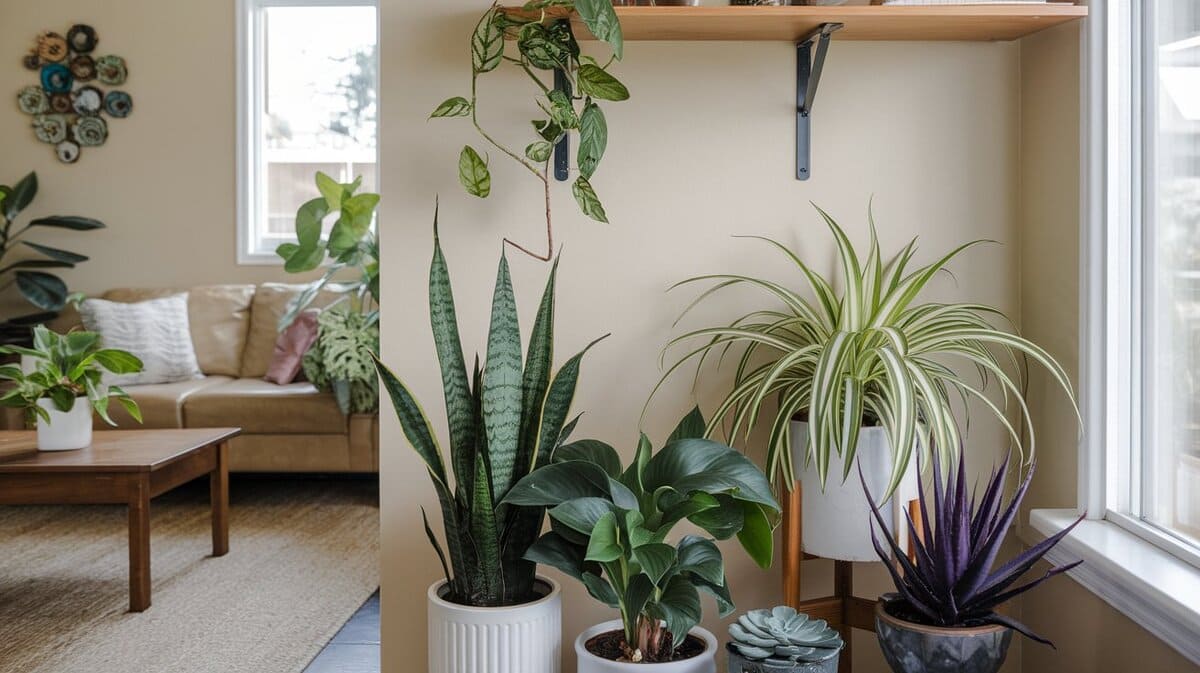
2-How to Care for Low Light Indoor Plants :
· Watering and Fertilizing Tips for Low Light Plants :
Less light means low watering for low light indoor plants as compared to those growing in the bright light condition. One has to ensure that the soil gets a undertakes a drying process between watering sessions. As a result, they become prone to root rot which is an infamous problem with these plants. There is always the rule of thumb of watering the plants when the top soil layer has hardened or gone slightly dry.
If your low light plants are actively growing, in spring and summer, they should be fertilized every 4-6 weeks with a diluted balanced fertilizer. Nonetheless, as a rule, most plants do not need nutrition during the dormant season and so you should be able to cut or eliminate fertilization during the fall or winter season.
· The Best Soil Mix for Low Light Plants :
An ideal soil that low light indoor plants should be grown in should have good drainage. This is preferable because it is made up of potting soil, perlite and peat moss; so it drains well, but retains moisture for use by the plant. This mix encourages healthy formation of roots and also helps to avoid water logging.
It also possible to apply organic matter like compost to bring about fertility of the soils. This will ensure that your plants receive nutrient in a slow stream and also help in enhancing soil texture.
4. Common Low Light Indoor Plant Problems and How to Fix Them :
Signs Your Plant Needs More Light :
Thereby, proving that low light plants can still indicate that they are hungry for light. Common indicators include:
· Yellowing Leaves:
This may be due to over head water or lack of light or both depending on the type of plant it is. This can also be attributed to under or over watering, a technique in which the state of the foliage should be checked and so with the supplies of nutrients.
· Leggy Growth:
If the plant is reaching horizontally to one place then it may require more light. Leggy growth is attained when plants start sprawling for light and hence, stems become thin stretched and foliage becomes scanty.
· Slow Growth:
Now if your plant is totally stagnant and isn’t showing any growth it mostly likely that the plant does not get enough light. Some plants may lose their functionalities for some time and this can be credited to a dormant phase however if a plant is dormant for long then there can be a problem with light conditions.
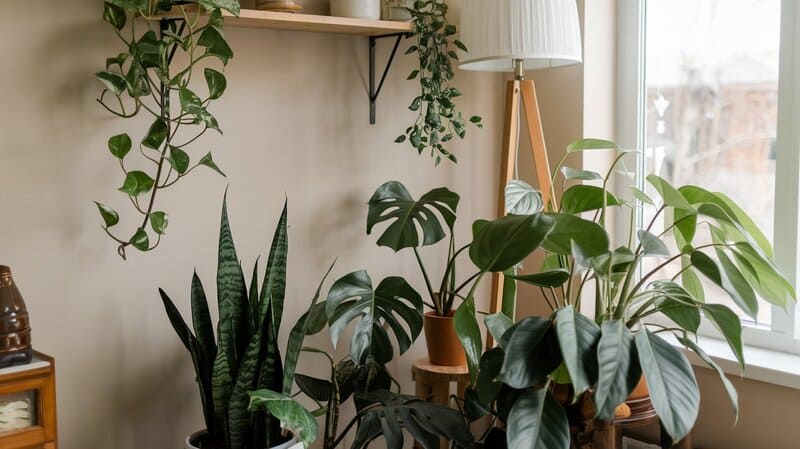
How to Revive Struggling Low Light Plants :
If the conditions for your low light plants are unsuitable in some way, try repositioning your plant to one that has just a little less light than the darkness it was accustomed to. While it is impossible to avoid shock completely, one should try to avoid exposing the plant to new light conditions altogether.
Feel the soil with your fingers and practice when to water the plants next time. If this is the case, you should avoid watering your plant for a while and wait until the roots of the plant dry out before watering again. It is also advisable to pinch off any wilting or turning yellow leaves so that the plant can use the resources to grow young leaves.
In case you think the plant lacks certain nutrients, consider trans placing the plant in a new potting mix or adding fertilizer. This can help to rejuvenate your plant and stimulates new growth.
5. Top 20 Low Light Indoor Plants for Beginners :
Here’s a curated list of the 20 best low light indoor plants, each requiring minimal light and care, making them perfect for beginners:
· Snake Plant or the scientifically known Sansevieria trifasciata
With its tall thin leaves standing erect the snake plant is among the easiest plants to cultivate. It can also grow in low light conditions and this makes it a lover among the indoor gardeners. Due to its ability of absorbing air pollutants it is also appropriate for use in a room as an air purifying option.
· ZZ Plant or Aroid or Elephant Ear (Zamioculcaszamiifolia)
ZZ plant has crispy, dark green leaves and is known to be very forgiving of environment inconsistency. It prefers a dark area and hardly needs water, therefore this plant is suitable for people with little time to attend to the plant’s needs or even a beginner in plant keeping.
· Pothos (Epipremnumaureum)
Climbing in nature and coming with a trailing vine, pothos can be left to climb or put in hanging baskets. The plant has a heart shaped leaves which are hardy and stays green irrespective of low light conditions. It also occupies a place as an air-purifying plant and is found in different types.

· Spathiphyllum spp. commonly known as peace lily.
A common household plant that has white colored flowers and can grow effectively under low light conditions the peace lilly is also known to have air purifying properties. It prefers slightly moist soils it will not punish you for occasional neglect and forgetting to water the plant.
· Outdoor: leaf plant Philodendron (Philodendron spp.)
Philodendrons are fairly diverse plants, and every single one of them can be placed in a low-light part of your house. They also can be propagated easily and that means you can multiply your indoor garden.
· Chlorophytum comosum popularly known as Spider Plant
It has “babies” or offshoots that can be grown in a easy way in this plant. This one is characterized by arching leaves and is referred also as being an air-purifying plant. Spider plants are adaptable to the different indoor environments and will do fine.
· Cast Iron Plant is scientific name Aspidistra elatior.
More to the name the cast iron plant is a highly rugged plant with low light, temperature fluctuations, abilities to be neglected. This type is also suitable for people who have no experience in gardening at all.
· Chinese Evergreen (Aglaonema spp.)
The Chinese evergreen is an easy-to-care plant with variegated leaves which naturally adapt to Asian non-irrigated low light and low humidity environment. It is however renowned for its specialization in different types of indoor climates.
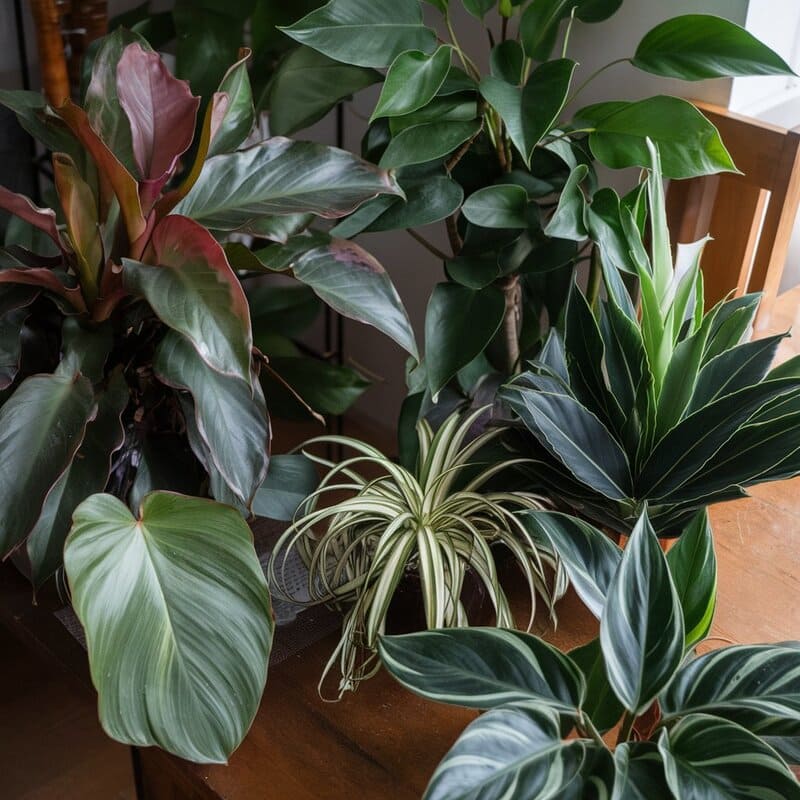
· Dracaena (Dracaena spp.)
Dracaena plant is available in a wide variety and all of them boasts long and kind of thin-like leaves. It is versatile and can grow well under circumstances where the lighting is low, adding the beauty of the fountains to homes and offices.
· Bamboo Palm (Chamaedoreaseifrizii)
Among the most attractive indoor plants is the bamboo palm which gives a tropical touch to indoor conditions. It prefers oblique light and can be used in air purification inside living spaces to improve the quality of air.
· Astrophytummyriostigma or also known as Bishop’s Cap
Bushy and skinny cactus that can survive with comparatively low amount of light coming to its territory, Bishop’s Cap look quite exotic. That is why, its form and requirement for the care are also classification points.
· Meaning of Lucky Bamboo (Dracaena sanderiana)
The green stalks and bright leaves to be visible mostly in water are not bamboos but a variety of Dracaena. This variety is very low maintenance and can therefore grow successfully under inadequate light which is common indoors.
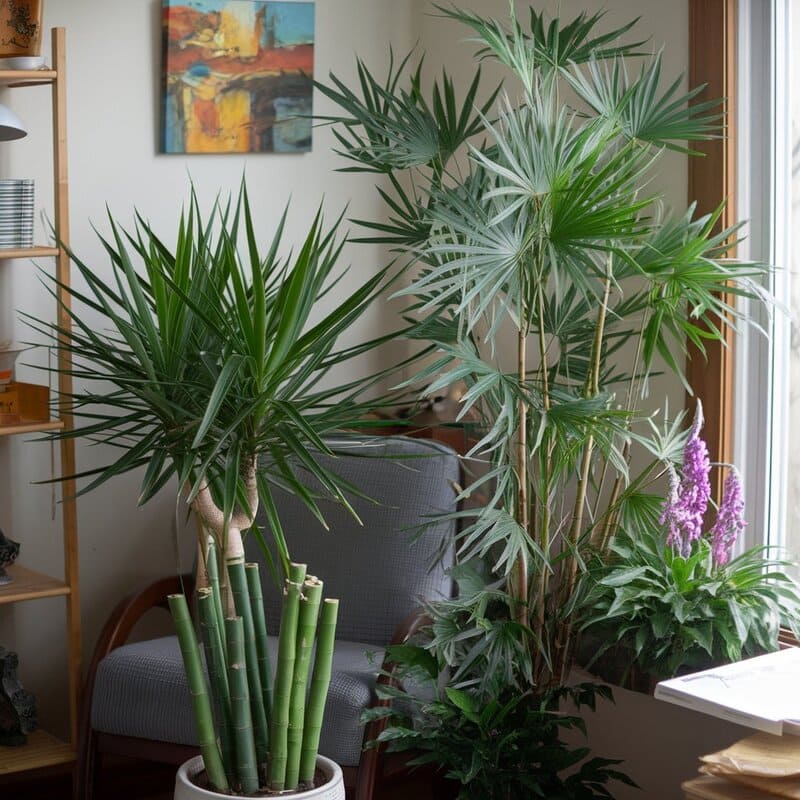
· Philodendron hederaceum or also known as Heartleaf Philodendron
This variety has really beautiful heart shaped leaves and is ideal for hanging baskets. The plant is very tolerant of lesser light conditions and therefore loved by most plant lovers.
· Parlor Palm (Chamaedorea elegans)
Also known as the ‘European palm, the parlor palm has fine, feathery foliage that does well in low-light offices. It also brings some sophistication and it is excellent if you need some greenery at some place.
· Rubber Plant (Ficus elastica)
Popular for their large,green and shiny leaves, rubber plants can cope with the low light but they are known to do well in the bright light. While hunting for large chandeliers, these ones can be big enough to make dramatic manifestations in different rooms.
· Maidenhair Fern, (Adiantum spp,.).
Maidenhair ferns have very slender, almost filigree foliage, and while they like a occasionally damp environment, they don’t require direct sunlight: great for indoor planting in kitchens and bathrooms.
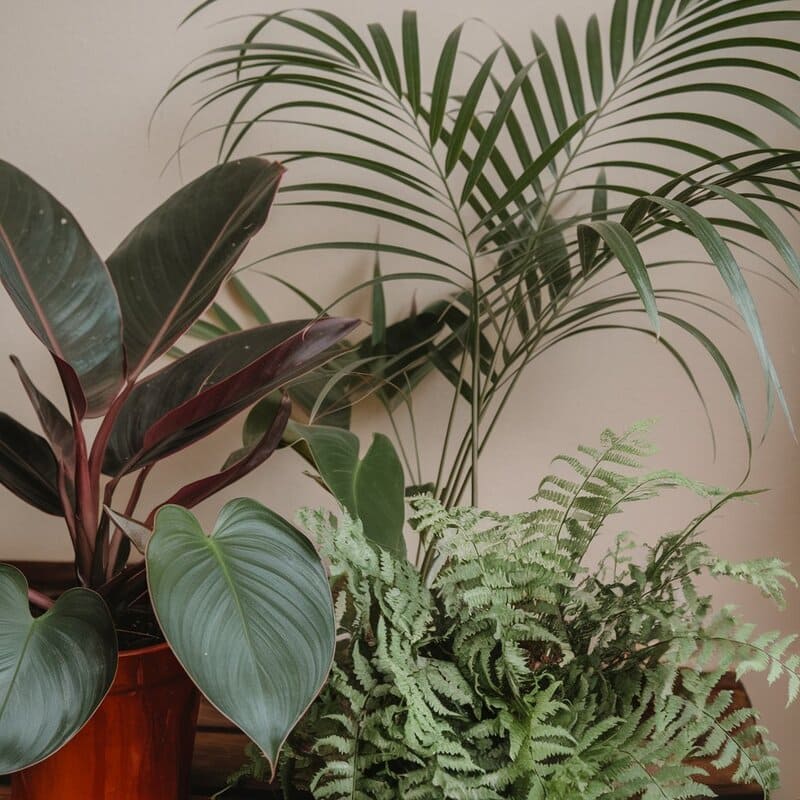
· Ferns (Various species)
Some ferns suitable for the home include the Boston fern and bird’s nest fern which prefers shady locations and high humidity as is common in the washrooms.
· Nerve Plant (Fittonia spp.)
It has leaves with prominent veins and grows best in indirect light and humidity so it is ideal for terrariums or low light environment. It brings that splash of color to your lawn especially with its lovely green leaves.
· Corn Plant (Dracaena fragrans)
The corn plant has very long and graceful leaves and is a very effective air purifier. It prefers slightly shaded positions and can reach a considerable size; in this way, it will become the stunning focal point of your interior.
· Aloe Vera. (Aloe barbadensismiller)
Although aloe vera thrives best under bright light it can adapt to low light sometimes, hence is flexible. It is also used for medical purposes and makes the plant aesthetically pleasing, while also being a functional addition to your indoor garden.
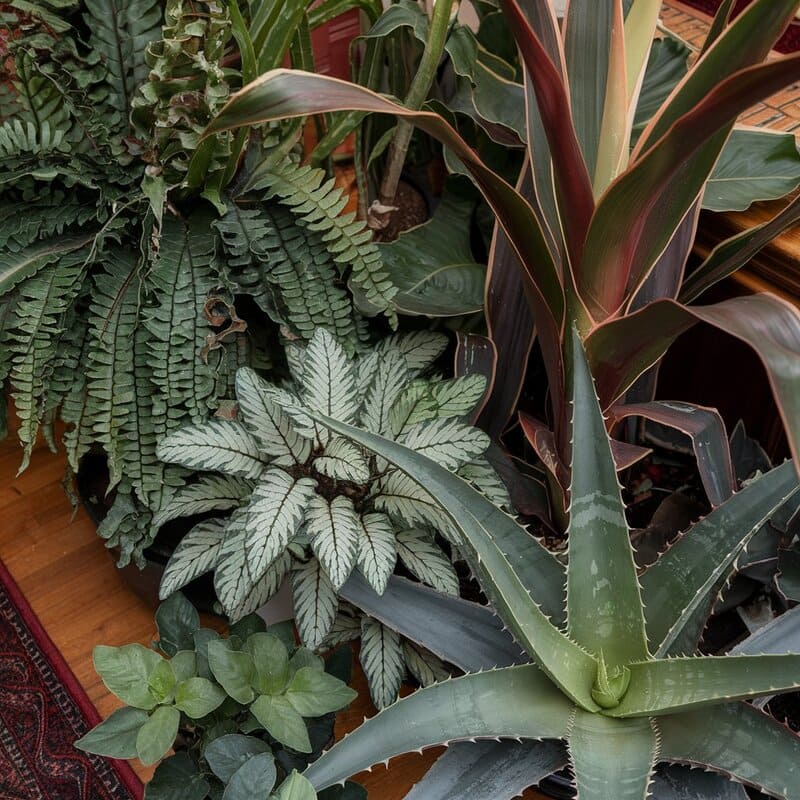
6-How to Create the Perfect Environment for Low Light indoor Plants:
Adjusting Humidity and Temperature for Optimal Growth :
Most low light indoor plants require moderate humidity in the atmosphere in which they are grown. If your home is very dry, running a humidifier is recommended or placing a tray with water nearby your plants. Almost all low light plants are comfortable in temperature levels ranging from 60°F to 75°F (15°C to 24°C).
Another aspect is keeping constant temperatures, which means not placing the plants near a draft, air conditioner or heater since dramatic changes affect them.
Best Spots in Your Home for Low Light Indoor Plants
To create an ideal environment for your low-light indoor plants, consider placing them in areas where they can receive indirect light, such as:
- Near north-facing windows:
These offer fairly stable but low levels of light – perfect for low light plants.
- In rooms with bright, filtered light:
Homeowners can choose sheer curtains since they can reduce direct sun light and offers plants a softer light that they prefer.
- On shelves or furniture:
In a way, raising plants enable them touch new light without being on direct sunshine bearing and hence encourage growth.
Additional Tips for Plant Placement :
- Rotate your plants:
If you have time and opportunity, turn the plants around every few weeks so all sides are in sunlight. This in turn serves to bring about balance growth or even growth as implied by the concept.
- Group plants together:
It will be easy to set up a plant corner that will increase the humidity and help to improve conditions for all the plants there.
- Consider using grow lights:
If the house you live in doesn’t get enough light, you should use LED grow lights. It can produce light without producing undesirable heat that may harm your plants in one way or the other.
Conclusion :
Indoor low light plants are indeed one of the best bets especially for people who want to introduce nature into their homes but do not have sufficient light to support the plants. As such, these plants can be easily grown as they require very little care and will do well in even the most temperate areas of your house. Hence, the best way is to identify the care needs of your plants, and learn to respond to a specific variety, enabling you to gain all the related benefits of indoor gardening without detriment to your home’s beauty.
Nonetheless, here are 20 low light indoor plants that should suit both the novice and the most experienced indoor gardener. Happy gardening! The essence and beauty of landscape design is that by picking the most suitable plants – and of course, if they are cared for properly – greenery improves one’s quality of life and aesthetics of the area in question. If properly informed and a little bit patient, the great dream of having a beautiful and relaxing indoor garden is more than real.
"This content is useful - share it on social media!"

